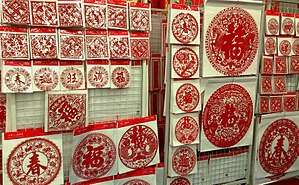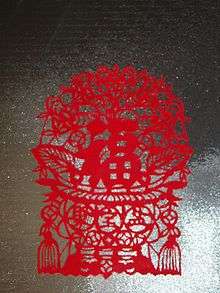Chinese paper cutting
The art of paper cutting (jiǎnzhǐ 剪纸) in China may date back to the second century CE, since paper was invented by Cai Lun in the Eastern Han Dynasty in China. As paper became more affordable, paper-cutting became one of the most important types of Chinese folk art. Later, this art form spread to other parts of the world, with different regions adopting their own cultural styles. Because the cut-outs are often used to decorate doors and windows, they are sometimes referred to as chuāng huā (窗花), window flowers or window paper-cuts. People glued the papercuts to the exterior of windows, so the light from the inside would shine through the negative space of the cutout.[1] Usually, the artworks are made of red paper, as red is associated with festivities and happiness in Chinese culture, but other colours were also used. Normally paper-cutting artwork is used on festivals like Spring Festival, weddings and childbirth. Papercuts always symbolize luck and happiness.


Origin
Chinese paper-cutting originated from ancient activities of worshipping ancestors and gods, and is a traditional part of Chinese culture. According to archaeological records, it originates from the 6th century, although some believe that its history could be traced as far back as the Warring States period (around 3 BC),[2] long before the paper was invented. At that time, people used other thin materials, like leaves, silver foil, silk and even leather, to carve hollowed patterns. Later, when paper was invented, people realized that this material was easy to cut, store and discard, and paper became the major material for this type of artwork. During the Ming and Qing dynasties (1368–1912), this artistry witnessed its most prosperous period. For over a thousand years, people (mainly women) have been making paper-cuts as part a leisure activity. They created different type of paper-cutting and shared and passed this traditional craftsmanship to their children, so that this traditional art style became more and more popular and is still practiced to this day.
Paper is a kind of material which mildews and rots easily. In the southeast of China, it usually rains in May and June, which makes paper mildew and rot quickly. As a result, people in southeast did not keep them, and it is hard to find paper-cutting from that time. On the contrast, the weather in the northwest of China is usually dry, which makes it possible to find paper-cutting made in the Northern dynasties in Turpan, Sinkiang province.
When paper-cutting passed down to the Tang dynasty, the skills of handcraft became mature. Paper-cutting was not only a kind of handcraft, but also a piece of artwork, as it could express the idea through the pattern. In Ming and Qing dynasty, paper-cutting experienced its peak development. Folk paper-cutting spread to a wider range and had abundant means of artistic expression. Paper-cutting was used to decorate doors, windows and walls to show happiness and festival.
Classification
Paper-cutting is one of the oldest and the most popular folk arts in China. It can be geographically divided into a southern and a northern style. The southern style, represented by works from Yangzhou in Jiangsu Province and Leqing in Zhejiang Province, features ingenious and beautiful designs, exquisite carving and interesting shapes. The northern style, mainly from Yuxian and Fengning in Hebei Province and best represented by works from northern Shaanxi, features exaggerated shapes, vigorousness, vivid depictions and diverse patterns.
The style of window paper-cuts is usually free, except the flower pattern on the corner. The theme of window paper-cuts has a wide range, the most popular of which is based on the stories of traditional Chinese opera. As most buyers are farmers, the content of window paper-cut usually describe farming, spinning, fishing and poultry farming.
Symmetry

There are basic cut-outs, consisting of a single image, and symmetrical designs, that are usually created by some folding over a proportioned crease, and then cutting a shape, so that when unfolded, it forms a symmetrical design. Chinese paper cuttings are usually symmetrical. The paper cut outs are usually in an even number series of 2, 4, 24, etc.
Uses
Today, paper cuttings are chiefly decorative. They liven up walls, windows, doors, columns, mirrors, lamps and lanterns in homes and are also used on presents or are given as gifts themselves. Paper cut-outs pasted on or near entrances are supposed to bring good luck. Paper cuttings used to be used as patterns, especially for embroidery and lacquer work. Papercuts are used by younger generation as a decoration for their kits and books.
Paper-cutting was and is mostly used as a decoration, or an aesthetic way to express people's hopes, gratitude and other emotions. With a pair of scissors cutting through a piece of red paper, the paper-cuttings are endowed with a simple but exaggerated beauty. The vividly depicted paper-cuttings have different meanings. Some express the wish for a harvest or a wealthy life, such as paper-cuttings of a golden harvest, thriving domestic animals, good fortunes, a surplus year or a carp jumping over a dragon gate (a traditional Chinese story, indicating a leap towards a better life); some depict animals and plants, such as paper-cuttings of polecats, lions, kylins (Chinese mythical creature), jade rabbits (animal from a Chinese legend), pomegranates and peonies; some illustrate legendary figures or scenes from traditional myths or stories, such as paper-cuttings of the Yellow Emperor, the meeting of Niulang and Zhinv and 24 stories of filial piety; and others show people's gratitude towards life, such as paper-cuttings of a doll with two twisted hair on each side of the head, fish swimming through lotus and dishes. (a strong passion for life can be easily seen from the paper-cuttings of the women)
The most famous paper-cutting characters in Chinese are “福” (fú, meaning 'lucky') and “囍” (xǐ, meaning 'double happiness'). Even to this day, Chinese people love to hang paper-cutting of these two characters at their doors. “福” is usually used during the Chinese New Year's Festival, indicating people's wishes for a lucky year. “囍” can often be seen at the windows or door of newly-weds.
Window paper-cuts have a close relationship with Spring begins, as it has been a way to welcome spring since ancient times in China. In many areas in China, especially in North, when spring comes, people like to paste window paper-cuts on the window to express their happiness. Since Song and Yuan Dynasty, people change the time to the Spring Festival in order to welcome Chinese New Year. Through pasting window paper-cuts, people decorate their home to show their joy, happiness and good intentions.
Process
There are two methods of manufacture: one uses scissors, the other uses knives. In the scissor method, several pieces of paper — up to eight — are fastened together. The motif is then cut with sharp, pointed scissors.
Knife cuttings are fashioned by putting several layers of paper on a relatively soft foundation consisting of a mixture of tallow and ashes. Following a pattern, the artist cuts the motif into the paper with a sharp knife which is usually held vertically. Skilled crafters can even cut out different drawings freely without stopping.
See also
| Wikimedia Commons has media related to Jian zhi. |
References
- Zhang Shuxian. Chinese Folk Paper-cutting[J]. China Today (Chinese version), 2005,(05)
- Zhuang Zhiyun. Folk Paper-cutting[J]. Chuang Zuo Ping Tan, 2006,(02)